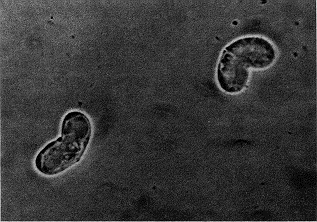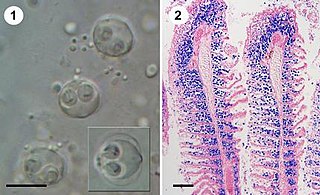
Myxobolus is a genus of myxozoa that includes important parasites of fish like Myxobolus cerebralis. The genus is polyphyletic, with members scattered throughout the myxozoa. Some stages of Myxobolus species were previously thought to be different organisms entirely, but are now united in this group. Some fish species, such as the thicklip grey mullet, can harbour a dozen of Myxobolus species.

Myxobolidae is a family of myxosporean parasites which typically infect freshwater fishes, and includes the economically significant species, Myxobolus cerebralis. They have been shown to have a complex life cycle, involving an alternate stage in an invertebrate, typically an annelid or polychaete worm.

Bivalvulida is an order of myxosporean parasites which contains a number of species which cause economically significant losses to aquaculture and fisheries, such as Myxobolus cerebralis and Ceratomyxa shasta. The Myxosporean stages of members of the bivalvulida are characterised by their two spore valves, which meet in a "suture line" which encircles the spore. They usually contain two polar capsules, but species have been reported which contain either one or four.

Pluteus is a large genus of fungi with over 300 species. They are wood rotting saprobes with pink spore prints and gills that are free from the stem.
Hirsutella is a genus of asexually reproducing fungi in the Ophiocordycipitaceae family. Originally described by French mycologist Narcisse Théophile Patouillard in 1892, this genus includes species that are pathogens of insects, mites and nematodes; there is interest in the use of these fungi as biological controls of insect and nematode pests. The teleomorphs of Hirsutella species are thought to belong to the genus Ophiocordyceps.
Ceratomyxa is a genus of myxozoan.
Crystallospora is a genus of Apicomplexa in the family Aggregatidae.
Thelohanellus is a genus of myxozoan in the family Myxobolidae..

Ceratomyxidae is a family of myxozoans.

Kudoa is a genus of Myxozoa and the only genus recognized within the monotypic family Kudoidae. There are approximately 100 species of Kudoa all of which parasitize on marine and estuarine fish. Kudoa are most commonly known and studied for the negative effects the genus has on commercial fishing and aquaculture industries.
Ceratomyxa brayi is a species of myxosporean parasites that infect gall-bladders of serranid fishes from the Great Barrier Reef. It was first found on Cephalopholis boenak.
Ceratomyxa hooperi is a myxosporean parasite that infects gall-bladders of serranid fishes from the Great Barrier Reef. It was first found on Epinephelus quoyanus.
Ceratomyxa nolani is a myxosporean parasite that infects gall-bladders of serranid fishes from the Great Barrier Reef. It was first found on Epinephelus quoyanus.
Ceratomyxa yokoyamai is a myxosporean parasite that infects gall-bladders of serranid fishes from the Great Barrier Reef. It was first found on Epinephelus maculatus.
Myxidiidae is a family of myxozoans.

Sphaerospora molnari is a microscopic endoparasite of carp in pond cultures and natural freshwater habitats in Central and Eastern Europe. In natural infections, S. molnari invades the epithelia of gills and surrounding skin regions. It then forms spores in between epithelial cells, causing sphaerosporosis, a pathological condition of the skin and gill tissues. Affected tissues show marked dystrophic changes and necrosis, causing secondary bacterial infections and resulting in osmoregulatory and respiratory failure. Mortalities can reach 100% but little is known about the overall distribution of the parasite species in European carp ponds or its economic impact on carp aquaculture.

Henneguya is a genus of myxosporean parasites belonging to the family Myxobolidae.
Chloromyxum is a genus of parasitic, myxosporean cnidarians belonging to the family Chloromyxidae.
Ortholinea is a genus of cnidarians belonging to the family Ortholineidae.

Sphaeromyxa is a genus of cnidarians belonging to the family Sphaeromyxidae.







